List of United States Supreme Court cases, volume 8
| Supreme Court of the United States | |
|---|---|
 | |
| Established | March 4, 1789[1] |
| Location | Washington, D.C. |
| Coordinates | 38°53′26″N 77°00′16″W / 38.89056°N 77.00444°WCoordinates: 38°53′26″N 77°00′16″W / 38.89056°N 77.00444°W |
| Composition method | Presidential nomination with Senate confirmation |
| Authorized by | Constitution of the United States, Art. III, § 1 |
| Judge term length | life tenure, subject to impeachment and removal |
| Number of positions | 9 (by statute) |
| Website | supremecourt |
| Chief Justice of the United States | |
| Currently | John Roberts |
| Since | September 29, 2005 |
| This article is part of the series on the |
| Supreme Court of the United States |
|---|
 |
| The Court |
|
| Current membership |
|
| Lists of justices |
|
| Court functionaries |
|
|
| Constitutional law of the United States |
|---|
 |
| Overview |
|
| Principles |
|
| Government structure |
|
| Individual rights |
|
| Theory |
|
This is a List of United States Supreme Court cases, volume 8 (4 Cranch) of United States Reports, decided by the Supreme Court of the United States from February 1807 to March 1808.[2]
Nominative reports[]
In 1874, the U.S. government created the United States Reports, and retroactively numbered older privately-published case reports as part of the new series. As a result, cases appearing in volumes 1–90 of U.S. Reports have dual citation forms; one for the volume number of U.S. Reports, and one for the volume number of the reports named for the relevant reporter of decisions (these are called "nominative reports").
William Cranch[]
Starting with the 5th volume of U.S. Reports, the Reporter of Decisions of the Supreme Court of the United States was William Cranch. Cranch was Reporter of Decisions from 1801 to 1815, covering volumes 5 through 13 of United States Reports which correspond to volumes 1 through 9 of his Cranch's Reports. As such, the complete citation to, for example, Jennings v. Carson is 8 U.S. (4 Cranch) 2 (1807).
Justices of the Supreme Court at the time of 8 U.S. (4 Cranch)[]
The Supreme Court is established by Article III, Section 1 of the Constitution of the United States, which says: "The judicial Power of the United States, shall be vested in one supreme Court . . .". The size of the Court is not specified; the Constitution leaves it to Congress to set the number of justices. Under the Judiciary Act of 1789 Congress originally fixed the number of justices at six (one chief justice and five associate justices).[3] Since 1789 Congress has varied the size of the Court from six to seven, nine, ten, and back to nine justices (always including one chief justice). When the cases in 8 U.S. (4 Cranch) were decided, the Court comprised these seven justices:
| Portrait | Justice | Office | Home State | Succeeded | Date confirmed by the Senate (Vote) |
Tenure on Supreme Court |
|---|---|---|---|---|---|---|
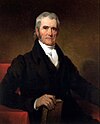
|
John Marshall | Chief Justice | Virginia | Oliver Ellsworth | January 27, 1801 (Acclamation) |
February 4, 1801 – July 6, 1835 (Died) |
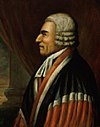
|
William Cushing |
Associate Justice | Massachusetts | original seat established | September 26, 1789 (Acclamation) |
February 2, 1790 – September 13, 1810 (Died) |

|
Samuel Chase |
Associate Justice | Maryland | John Blair, Jr. | January 27, 1796 (Acclamation) |
February 4, 1796 – June 19, 1811 (Died) |

|
Bushrod Washington |
Associate Justice | Virginia | James Wilson | December 20, 1798 (Acclamation) |
November 9, 1798 (Recess Appointment) – November 26, 1829 (Died) |
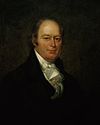
|
William Johnson |
Associate Justice | South Carolina | Alfred Moore | March 24, 1804 (Acclamation) |
May 7, 1804 – August 4, 1834 (Died) |
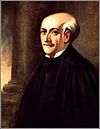
|
Henry Brockholst Livingston |
Associate Justice | New York | William Paterson | December 17, 1806 (Acclamation) |
January 20, 1807 – March 18, 1823 (Died) |
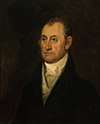
|
Thomas Todd |
Associate Justice | Kentucky | new seat | March 2, 1807 (Acclamation) |
March 3, 1807 – February 7, 1826 (Died) |
Notable cases in 8 U.S. (4 Cranch)[]

Ex parte Bollman[]
In Ex parte Bollman, 8 U.S. (4 Cranch) 75 (1807) the Supreme Court held that the constitutional definition of treason excluded mere conspiracy to levy war against the United States.[4] Erick Bollman and Samuel Swartwout were civilians who became implicated in the Burr-Wilkinson Plot. This plot supposedly consisted of Aaron Burr and James Wilkinson attempting to create an empire in the United States, ruled by Burr. In 1806, Wilkinson informed Thomas Jefferson of the plot, ending whatever may have actually been planned. Bollman and Swartwout attempted to recruit others into the plot, but these individuals informed the military, which promptly arrested them. The Court decided that "To constitute a levying of war, there must be an assemblage of persons for the purpose of effecting by force a treasonable purpose. Enlistments of men to serve against government is not sufficient."[4]
Citation style[]
Under the Judiciary Act of 1789 the federal court structure at the time comprised District Courts, which had general trial jurisdiction; Circuit Courts, which had mixed trial and appellate (from the US District Courts) jurisdiction; and the United States Supreme Court, which had appellate jurisdiction over the federal District and Circuit courts—and for certain issues over state courts. The Supreme Court also had limited original jurisdiction (i.e., in which cases could be filed directly with the Supreme Court without first having been heard by a lower federal or state court). There were one or more federal District Courts and/or Circuit Courts in each state, territory, or other geographical region.
Bluebook citation style is used for case names, citations, and jurisdictions.
- "C.C.D." = United States Circuit Court for the District of . . .
- e.g.,"C.C.D.N.J." = United States Circuit Court for the District of New Jersey
- "D." = United States District Court for the District of . . .
- e.g.,"D. Mass." = United States District Court for the District of Massachusetts
- "E." = Eastern; "M." = Middle; "N." = Northern; "S." = Southern; "W." = Western
- e.g.,"C.C.S.D.N.Y." = United States Circuit Court for the Southern District of New York
- e.g.,"M.D. Ala." = United States District Court for the Middle District of Alabama
- "Adm." = Admiralty Court (a federal court)
- "Ct. Cl." = United States Court of Claims
- "Ct. Com. Pl." = Court of Common Pleas (a state court)
- The abbreviation of a state's name alone indicates the highest appellate court in that state's judiciary at the time.
- e.g.,"Pa." = Supreme Court of Pennsylvania
- e.g.,"Me." = Supreme Judicial Court of Maine
List of cases in 8 U.S. (4 Cranch)[]
| Case Name | Page & year | Opinion of the Court | Concurring opinion(s) | Dissenting opinion(s) | Lower court | Disposition of case |
|---|---|---|---|---|---|---|
| United States v. Kid | 1 (1807) | per curiam | none | none | C.C.D. Pa. | remanded to divided lower court |
| Jennings v. Carson | 2 (1807) | Marshall | none | none | C.C.D. Pa. | affirmed |
| Rhinelander v. Insurance Co. | 29 (1807) | Marshall | none | none | C.C.D. Pa. | remanded to divided lower court |
| Montalet v. Murray | 46 (1807) | Marshall | none | none | C.C.D. Ga. | reversed for want of jurisdiction |
| United States v. Willings | 48 (1807) | Marshall | none | none | C.C.D. Pa. | affirmed |
| O'Neale v. Long | 60 (1807) | Marshall | none | none | C.C.D.C. | reversed |
| Smith v. Carrington | 62 (1807) | Marshall | none | none | C.C.D.R.I. | reversed |
| Pendleton v. Wambersie | 73 (1807) | per curiam | none | none | C.C.D. Ga. | reversed |
| Ex parte Bollman | 75 (1807) | Marshall | Chase | Johnson | C.C.D.C. | habeas corpus granted |
| Skillern's Ex'rs v. May's Ex'rs | 137 (1807) | per curiam | none | none | D. Ky. | reversed |
| French's Ex'x v. Bank of Columbia | 141 (1807) | Marshall | none | none | C.C.D.C. | reversed |
| Hopkirk v. Bell | 164 (1807) | per curiam | none | none | C.C.D. Va. | remanded to divided lower court |
| Hicks v. Rogers | 165 (1807) | per curiam | none | none | C.C.D. Vt. | remanded to divided lower court |
| United States v. Cantrill | 167 (1807) | Marshall | none | none | C.C.D. Ga. | judgment arrested |
| Sthreshley v. United States | 169 (1807) | Marshall | none | none | D. Ky. | reversed |
| Marshall v. Currie | 172 (1807) | Johnson | none | none | D. Ky. | reversed |
| Viers v. Montgomery | 177 (1807) | per curiam | none | none | D. Ky. | reversed |
| Diggs v. Wolcott | 179 (1807) | per curiam | none | none | C.C.D. Conn. | reversed |
| Wood v. Lide | 180 (1807) | Marshall | none | none | C.C.D. Ga. | affirmed |
| Fitzsimmons v. Newport Ins. Co. | 185 (1808) | Marshall | none | none | C.C.D.R.I. | reversed |
| Marshall v. Delaware Ins. Co. | 202 (1808) | Marshall | none | none | C.C.D. Pa. | affirmed |
| McIlvaine v. Coxe's Lessee | 209 (1808) | Cushing | none | none | C.C.D.N.J. | affirmed |
| The Brig Union | 216 (1808) | Marshall | none | Johnson | C.C.D. Del. | overruled |
| Pawling v. United States | 219 (1808) | Marshall | none | none | D. Ky. | reversed |
| Grant v. Naylor | 224 (1808) | Marshall | none | none | C.C.D. Md. | reversed |
| Woods v. Young | 237 (1808) | per curiam | none | none | C.C.D.C. | affirmed |
| Young v. Preston | 239 (1808) | per curiam | none | none | C.C.D.C. | reversed |
| Rose v. Himely | 241 (1808) | Marshall | Livingston, Johnson | none | C.C.D.S.C. | reversed |
| Hudson v. Guestier | 293 (1808) | Marshall | Johnson | Chase, Livingston | C.C.D.C. | reversed |
| Alexander v. Harris | 299 (1808) | Marshall | none | none | C.C.D.C. | affirmed |
| Chappedelaine v. Dechenaux | 306 (1808) | Marshall | none | none | C.C.D. Ga. | affirmed (part); reversed (part) |
| United States v. Vowell | 316 (1808) | per curiam | none | none | D. Ky. | dismissed for want of jurisdiction |
| City of Alexandria v. Patten | 317 (1808) | Marshall | none | none | C.C.D.C. | reversed |
| Dawson's Lessee v. Godfrey | 321 (1808) | per curiam | none | none | C.C.D.C. | affirmed |
| Mountz v. Hodgson | 324 (1808) | Marshall | none | none | C.C.D.C. | dismissed for want of jurisdiction |
| The Ship Charles Carter | 328 (1808) | Chase | none | none | C.C.D. Va. | affirmed |
| United States v. Gurney | 333 (1808) | Marshall | none | none | C.C.D. Pa. | remanded to divided lower court |
| Peisch v. Ware | 347 (1808) | Marshall | none | none | C.C.D. Del. | affirmed |
| Shearman v. Irvine's Lessee | 367 (1808) | Marshall | none | none | C.C.D. Ga. | affirmed |
| Alexander v. Baltimore Ins. Co. | 370 (1808) | Marshall | none | none | C.C.D. Md. | affirmed |
| Morgan v. Callender | 370 (1808) | per curiam | none | none | C.C.D. Orleans | dismissed for want of jurisdiction |
| Matthews v. Zane | 382 (1808) | Marshall | none | none | Ohio | jurisdiction of Supreme Court set |
| Young v. Bank of Alexandria | 384 (1808) | Marshall | none | none | C.C.D.C. | overruled |
| Spires v. Willison | 398 (1808) | Marshall | none | none | D. Ky. | reversed |
| Ramsay v. Lee | 401 (1808) | Marshall | none | none | C.C.D.C. | affirmed |
| Stead's Ex'rs v. Course | 403 (1808) | Marshall | none | none | C.C.D. Ga. | reversed |
| Higginson v. Mein | 415 (1808) | Marshall | none | Livingston | C.C.D. Ga. | reversed |
| Pollard v. Dwight | 421 (1808) | Marshall | none | none | C.C.D. Conn. | reversed |
| Croudson v. Leonard | 434 (1808) | Johnson | Washington | none | C.C.D.C. | reversed |
| Ex parte Lewis | 433 (1808) | per curiam | none | none | C.C.D. Pa. | remanded to divided lower court |
| The Schooner Betsey | 443 (1808) | Marshall | none | none | C.C.D.C. | reversed |
Notes and references[]
- ^ Lawson, Gary; Seidman, Guy (2001). "When Did the Constitution Become Law?". Notre Dame Law Review. 77: 1–37.
- ^ Anne Ashmore, DATES OF SUPREME COURT DECISIONS AND ARGUMENTS, Library, Supreme Court of the United States, 26 December 2018.
- ^ "Supreme Court Research Guide". Georgetown Law Library. Retrieved April 7, 2021.
- ^ a b Howell, Herbert A. (November 1917). "The Law of Treason". Virginia Law Review. 5 (2): 131–134. doi:10.2307/1064036. ISSN 0042-6601. JSTOR 1064036.
See also[]
- certificate of division
External links[]
- [1] Case reports in volume 8 (4 Cranch) from Court Listener
- [2] Case reports in volume 8 (4 Cranch) from the Caselaw Access Project of Harvard Law School
- [3] Case reports in volume 8 (4 Cranch) from Google Scholar
- [4] Case reports in volume 8 (4 Cranch) of Justia
- [5] Case reports in volume 8 (4 Cranch) from Open Jurist
- Website of the United States Supreme Court
- United States Courts website about the Supreme Court
- National Archives, Records of the Supreme Court of the United States
- American Bar Association, How Does the Supreme Court Work?
- The Supreme Court Historical Society
| Wikisource has original text related to this article: |
- Lists of United States Supreme Court cases by volume
- Lists of United States Supreme Court cases
- United States Supreme Court cases
- United States case law lists
- 1807 in United States case law

